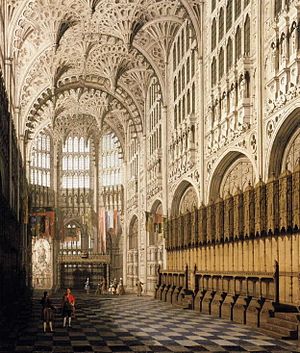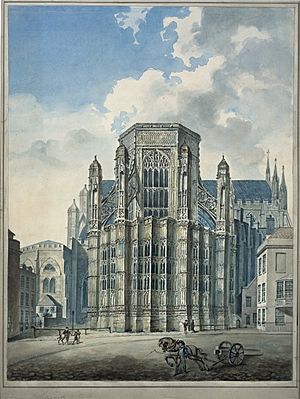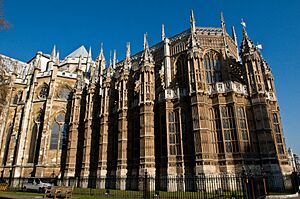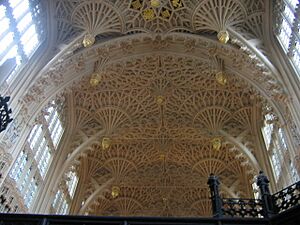Henry VII Chapel facts for kids

The Henry VII Chapel is a very special and large chapel located at the far eastern end of Westminster Abbey in London. It's also known as the Henry VII Lady Chapel. King Henry VII paid for its construction. You enter the chapel through beautiful brass gates and go up a few stairs.
The chapel has a main area with three sections, called aisles, and four parts, called bays. At the very end of the chapel is the altar. Behind the altar, you'll find the tombs of King Henry VII and his wife, as well as King James I. There are also five smaller chapels around the curved end of the main area.
One of the most amazing things about the chapel is its unique pendant fan vault ceiling. It looks like giant stone fans hanging down!
The chapel was built in a very fancy style called Perpendicular Gothic. It was so grand that a historian named John Leland called it the orbis miraculum, which means "the wonder of the world." Many kings and queens are buried here, including Henry VII, Edward VI, Mary I, Elizabeth I, James I, Charles II, and Mary, Queen of Scots.
Since 1725, the chapel has also been the main church for the Order of the Bath, which is a special group of knights. You can see their colorful banners hanging above the seats, called stalls.
Contents
History of the Chapel
Back in the 1200s, people across Europe started building chapels to honor the Virgin Mary. King Henry III built a Lady Chapel at Westminster Abbey as part of this trend. Later, in 1502, King Henry VII decided to build a brand new, much grander chapel. The old one was taken down in 1502, and construction on the new chapel began on January 24, 1503.
King Henry VII had three main reasons for building his chapel:
- First, he wanted to create a special place to honor and bury King Henry VI. Henry VI was expected to become a saint, but this never happened. So, Henry VII and his wife, Elizabeth of York, were buried in the tomb meant for Henry VI.
- Second, Henry VII wanted to build a more beautiful chapel dedicated to the Virgin Mary, replacing the older, simpler one.
- Third, he wanted a royal burial place for himself, his family, and future kings and queens. He hoped this important religious site would make his rule stronger and leave a lasting legacy.
Henry VII spent a lot of money on the chapel, over £14,000 between 1503 and 1509. In his will, he made sure even more money would be available if needed. The total cost of the chapel is thought to be around £20,000. A nobleman named Lord Bacon once said that Henry VII "dwelleth more richly dead in the monument of his tomb than he did alive."
In the 1700s, people believed that only royalty should be buried in this chapel. Most people buried there were indeed from royal families. However, some people who were not royal, like Oliver Cromwell, were buried there for a time. But when the monarchy was restored, many of these non-royal burials were removed.
Amazing Fan Vault Ceiling
The Henry VII Chapel is most famous for its incredible pendant fan vault ceiling. It's considered one of the best examples of this type of vaulting. This ceiling was also the first to combine hanging pendants with fan vaulting.
To create the fan vault, the ceiling is first divided into square-like sections. These sections are formed by arches along the walls and larger arches that stretch across the chapel. In the Henry VII Chapel, these sections are almost perfectly square.
Then, stone ribs and panels are added to these sections. The curved ribs are cut from single pieces of stone and fit together perfectly with the panels. These ribs spread out from points on the wall, forming cone-like shapes. These shapes need a lot of pressure to stay strong.
Usually, special stone pieces called spandrels provide this pressure. But in the Henry VII Chapel, hanging pendants replace these spandrels. These pendants still provide the necessary support and also make the ceiling look even more complex and beautiful.
The pendants also have another important job. They are cut from single stones and fit into the main arches that cross the chapel. By being part of these arches, the pendants don't need extra support.
When the chapel was built, pendant vaults were very new. They were first seen in the Divinity School at Oxford.
Other Cool Features
We don't know for sure who designed the chapel, but it's thought that Robert Janyns the Younger was responsible for much of its design. The chapel has a main area with three aisles and four sections. The aisles are separated by rows of mahogany seats, called stalls. These stalls are in the North, South, and Central aisles. Many monuments and floor stones dedicated to important nobles are found here.
Above the stalls, you can see many sculptures. Between the sculptures hang the colorful banners of the Knights of the Order of the Bath. Above this level are three rows of smaller windows, which let in light. The window designs show four larger windows, one in each section, each made up of these three smaller windows.
Much of the original stained glass was destroyed a long time ago. The East Window, above the central small chapel, and the Donor Windows in the west, were added more recently in 2000 and 1995. In 2013, two new stained glass windows were installed on either side of the East Window.

The altar is at the end of the chapel, and behind it are the tombs of Henry VII, his wife, and James I. There are five small chapels around the curved end. These chapels originally had altars and were used for private prayer by the royal family. We don't know what they were dedicated to anymore.
When you enter the chapel, you pass through amazing bronze gates. These gates are very detailed and show off King Henry VII's claim to the English crown. They are decorated with many royal symbols to show his right to rule. Inside, the dark mahogany stalls stand out against the light stone walls and ceiling. These stalls also make the chapel feel very tall.
The stalls were added at different times. Some are original, while others were added later for the growing number of Knights of the Order of the Bath. Each living Knight of the Most Honourable Order of the Bath was given a stall. When a knight was installed, his stall was decorated with his crest, coat of arms, and a special banner. This banner stayed in the chapel even after the knight died. These banners still decorate the chapel today. In the 1800s, there were too many knights for the chapel. Now, only the most senior knights are given stalls.
The altar and Henry VII's tomb were made by the same Italian artist, Pietro Torrigiano. The tomb was started in 1512. It was sculpted by an artist from the Italian Renaissance, so its style is different from typical English art of that time. The small cherub figures on the corners are especially unique. The altar was started in 1517, but Torrigiano left the country before finishing it. Benedetto da Rovezzano completed it in 1526.
The original altar was made of terracotta, white marble, and gilded bronze, but it was destroyed a long time ago. The current altar is a copy based on pictures of the original. Two original pillars and two new ones support the rebuilt altar. The sculptures of saints and Apostles above the stalls are also very important. Henry VII believed that these religious figures would help him get into Heaven, which was a big reason why he built the chapel and decorated it so richly.
Important People Buried Here
- Anne Hyde, Duchess of York and Albany
- Anne de Mowbray, Duchess of York and Norfolk
- Anne, Queen of Great Britain
- Anne of Denmark, Queen of Scotland and England
- Antoine Philippe, Duke of Montpensier
- Arthur Penrhyn Stanley
- Caroline of Ansbach, Queen of Great Britain
- Catherine of Valois, Queen of England
- Charles II of England
- suspected Edward V of England
- Edward VI of England
- Elizabeth I of England
- Elizabeth of York, Queen of England
- Elizabeth Cavendish, Countess of Devonshire
- Esmé Stewart, 2nd Duke of Richmond
- George II of Great Britain
- George Monck, First Duke of Albemarle
- George Villiers, 1st Duke of Buckingham
- Henry VII of England
- James Butler, 1st Duke of Ormonde
- James VI and I
- John Sheffield, 1st Duke of Buckingham and Normanby
- Ludovic Stewart, 2nd Duke of Lennox, Second Duke of Lennox and Duke of Richmond
- James Hamilton, 6th Earl of Abercorn
- Margaret Beaufort, Countess of Richmond and Derby
- Margaret Douglas, Countess of Lennox
- Mary I of England
- Mary II of England
- Mary, Queen of Scots
- Oliver Cromwell (His body was removed after the monarchy was restored)
- suspected Richard of Shrewsbury, Duke of York
- William III of England
- Prince William, Duke of Gloucester
- James Hamilton, 7th Earl of Abercorn
Images for kids
See also
 In Spanish: Capilla de Enrique VII para niños
In Spanish: Capilla de Enrique VII para niños





